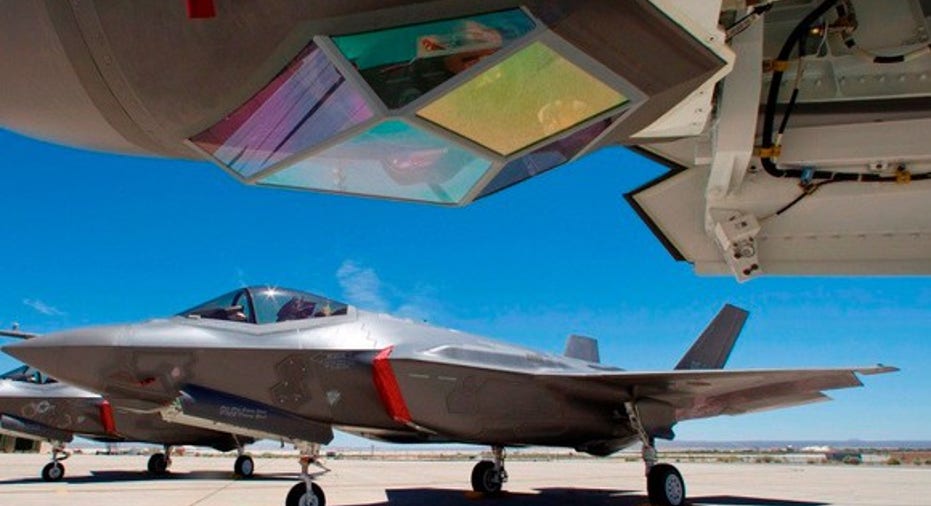F-35 Is a Massive Win for Lockheed Martin Stock

Lockheed Martin's (NYSE: LMT) F-35 stealth fighter jet is a marvel of technology. It could also do marvelous things for Lockheed Martin's stock.
Lockheed Martin is the nation's largest pure-play defense contractor, producing at one and the same time the world's most popular fighter jet (the F-16 Falcon), the most popular military aircraft that's not a fighter jet (the C-130 Hercules), and the most popular combat helicopter as well (the Sikorsky Black Hawk). As it steps into the 21st century, Lockheed is aiming to ensure its dominance of military aerospace with its newest product, the F-35 Lightning II joint strike fighter.
Underbelly of the beast: Lockheed Martin's F-35. Image source: Lockheed Martin.
Big news on the F-35
Lockheed Martin took another big step toward that goal last month, when the Pentagon announced -- in its daily recap of big contracts -- that it has just awarded Lockheed Martin $7.2 billion in new F-35 contracts. As the Pentagon explained, Lockheed has been asked to produce 90 new F-35s in various configurations for various buyers, including:
- 44 F-35A conventional take-off and landing (CTOL) fighters for the U.S. Air Force
- Nine F-35Bs capable of vertical take-off and landing (VTOL) for the Marines, and two more for the Navy
- 16 F-35As and three F-35Bs for allied nations participating in the F-35 project
- 16 F-35As for nonparticipating "foreign military sales" customers
(The Pentagon did not say so specifically, but judging by where the "work will be performed," it appears that the allied customer may be Britain, and the "foreign" customer Japan.)
What it means for Lockheed Martin
One day, the F-35 could account for as much as 50% of the revenueLockheed takes in in a given year. Already, ramping sales of Lockheed's most (in)famous product has the F-35 accounting for 21%of Lockheed Martin's business. And it only takes a bit of number-crunching to see why the F-35 project is gaining so much steam.
The bulk of the F-35s ordered by the Pentagon last month -- 76 out of the 90 -- are for the cheapest of the three F-35 variants that Lockheed Martin builds: the F-35A CTOL fighter.
Now, it's well known that the Air Force has asked Lockheed to bring the F-35's average cost per plane down to $85 million. Last time we checked in on the company, at the time of the Pentagon's $1.3 billion May 2016 plane purchase, Lockheed had already succeeded in dropping that average cost below $100 million (engines not included). This latest bulk purchase of F-35s, however, shows that Lockheed has made even more progress on that front.
Ninety aircraft sold for $7.2 billion works out to a per-plane cost of just under $80 million. Again, this is exclusive of engines, which cost about $16.5 million per plane. Add those engines into the mix, and the F-35 is still costing the Pentagon close to $96 million. But even so, this is a remarkable accomplishment. Assuming Lockheed can fulfill the Pentagon's order on-time and on-budget, it appears that the company has succeeded in shaving 20% off the airplane's cost in just six months' time.
What it means for investors
As Lockheed continues to succeed in shrinking the F-35's cost, customer interest in the aircraft -- both in the U.S. and abroad -- is likely to pick up. That $20 million reduction in sticker cost is going to ease a lot of concerns about the airplane's performance. If Lockheed succeeds in keeping the plane's price down, I predict it will result in a big boost to the company's top line in the quarters to come.
And on the bottom line?
Well, at the 10.7% operating profit margin that Lockheed's Aeronautics business earns on its products, this sale alone is likely to yield about $770 million in pre-tax profits for Lockheed -- about $2.62 per share. Crunching the numbers provided by S&P Global Market Intelligence, I estimate that after taxes, this single sale will be worth about 13% of the profitthat Lockheed Martin nets in a year. That's still not up to par with the 21% of Lockheed's revenue stream that F-35 sales represent, but it's getting there.
And the closer the F-35 gets to pulling its weight on Lockheed Martin's bottom line, the closer I think the stock gets to becoming a "buy."
10 stocks we like better than Lockheed Martin When investing geniuses David and Tom Gardner have a stock tip, it can pay to listen. After all, the newsletter they have run for over a decade, Motley Fool Stock Advisor, has tripled the market.*
David and Tom just revealed what they believe are the 10 best stocks for investors to buy right now... and Lockheed Martin wasn't one of them! That's right -- they think these 10 stocks are even better buys.
Click here to learn about these picks!
*Stock Advisor returns as of November 7, 2016
Rich Smithdoes not own shares of, nor is he short, any company named above. You can find him onMotley Fool CAPS, publicly pontificating under the handleTMFDitty, where he's currently ranked No. 340 out of more than 75,000 rated members. Follow him on Facebookfor the latest in defense news.
The Motley Fool has no position in any of the stocks mentioned. Try any of our Foolish newsletter services free for 30 days. We Fools may not all hold the same opinions, but we all believe that considering a diverse range of insights makes us better investors. The Motley Fool has a disclosure policy.



















